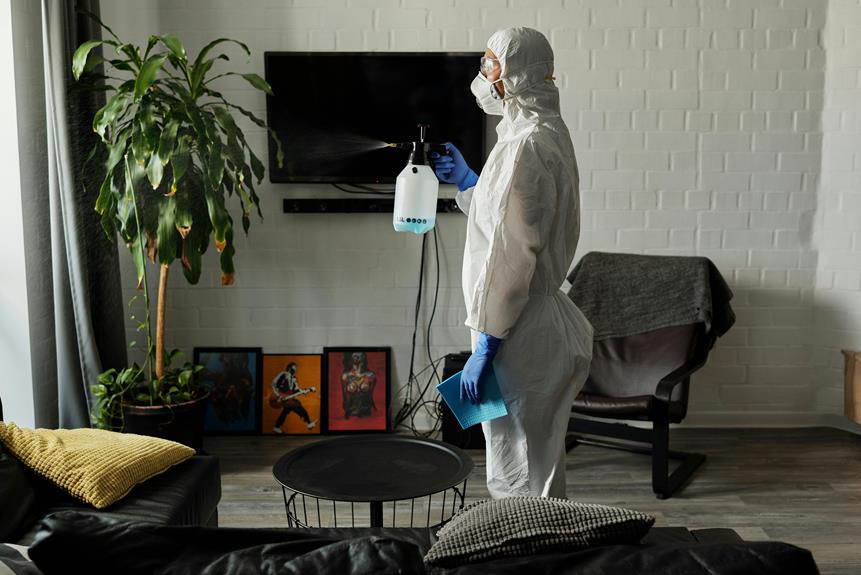Your TV might be freezing and pixelating due to several key issues. First, check cable connections for security and damage—loose or frayed cables disrupt signals.
Next, inspect your internet signal; switch to a hard wired Ethernet connection for stability and disconnect unused devices.
Updating your TV’s firmware can also resolve software bugs and enhance performance. Perform a soft reset by powering off and unplugging your TV and any connected devices.
Lastly, examine your antenna or satellite for obstructions and ensure proper positioning. When you next wonder : Why Is My TV Freezing and Pixelating? By addressing thethe above, you can greatly improve your viewing experience. Let’s explore each step further.
Key Information
- Ensure all cable connections are secure and undamaged to prevent signal disruption.
- Check WiFi signal strength or switch to a wired Ethernet connection for better internet performance.
- Update your TV firmware regularly to fix bugs and enhance performance.
- Inspect and maintain your antenna or satellite for obstructions and proper positioning.
- If you require TV wall mounting, simply click the “Book Now” button and follow the steps to secure your appointment.
Check Cable Connections
Have you checked for any loose or damaged cables connecting your TV equipment, as these can be essential culprits behind freezing and pixelation issues?
Make sure all cable connections are secure to maintain a stable signal and prevent transmission interruptions.
Loose connections can disrupt the signal, causing pixelated images and frozen screens. Visually inspect each cable for any signs of wear or damage. Replace any frayed or bent cables immediately to avoid potential issues.
Regularly maintaining your cables can greatly improve your viewing experience. Promptly addressing these problems will help resolve freezing and pixelation, ensuring smooth and uninterrupted TV watching.
Proper cable care is vital for a seamless and enjoyable experience.
Inspect Internet Signal
When experiencing freezing and pixelation, start by checking the WiFi signal strength on your TV to confirm a stable and robust connection.
If the signal is weak, use an internet speed test app on your TV to identify potential network issues. Switch from WiFi to a wired Ethernet connection for better reliability, as this reduces interference.
Disconnect any unused devices to free up bandwidth, which can greatly improve your TV’s performance.
Additionally, check for signal interference from other electronic devices or thick walls obstructing the WiFi signal.
Update TV Firmware
Updating your TV firmware is an essential step to fix freezing and pixelation issues, as it addresses software bugs and enhances overall performance.
Manufacturers regularly release updates to improve functionality and compatibility with new technologies.
To update your firmware, check your TV’s settings menu for an update option or visit the manufacturer’s website for detailed instructions.
Here’s a quick guide:
| Step | Action | Details |
|---|---|---|
| 1 | Access Settings | Navigate to the TV’s settings menu |
| 2 | Select Firmware Update | Look for ‘Software Update’ option |
| 3 | Download and Install | Follow on-screen prompts |
| 4 | Restart TV | Reboot to apply the update |
Regularly updating your firmware can resolve connectivity issues, optimise video quality, and prevent freezing problems.
Reset Devices
After updating your TV firmware, resetting your devices is another effective solution to tackle freezing and pixelation issues.
Start by powering off your TV and unplugging it for at least 60 seconds to perform a soft reset. This action can clear temporary glitches and refresh the system.
Similarly, unplug your set-top box, wait for a minute, and then plug it back in to reset the device.
Performing these resets on both your TV and set-top box can greatly improve overall performance and reduce issues.
Regularly resetting your devices helps maintain peak functionality, ensuring a smoother viewing experience.
Consistently addressing these technical steps can make a noticeable difference in minimising freezing and pixelation problems.
Examine Antenna and Satellite
Checking your antenna and satellite setup is crucial for guaranteeing a stable and high-quality TV signal, free from freezing and pixelation. Start by inspecting your satellite dish and antenna for any obstructions like trees or buildings that might be blocking the signal path.
Also, clear away any debris or water that has accumulated on the dish, as these can degrade signal quality. Adjust the antenna’s position to face the nearest broadcast tower for best reception.
Regular maintenance and precise dish alignment can prevent many issues. Here are key steps:
- Inspect for obstructions: Remove any blockage in the line of sight.
- Clear debris: Ensure the dish is clean and dry.
- Position correctly: Aim the antenna towards the broadcast tower.
Frequently Asked Questions
Why Is My TV Picture Breaking up and Freezing?
Your TV picture’s breaking up and freezing likely because of signal interference, weak reception, or network congestion. Check for loose cables, upgrade outdated equipment, adjust antenna positioning, or contact your service provider for a signal boost.
How Do I Stop My TV From Pixelating?
To prevent your TV from pixelating, make sure all cable connections are secure, adjust your antenna or satellite dish for best reception, and bypass any splitters. If the issue continues, contact your service provider for further troubleshooting.
Why Does My TV Signal Keep Freezing and Pixelating?
Your TV signal keeps freezing and pixelating due to loose or damaged cables, signal obstructions, weather conditions, or network congestion. Check your cables and contact your service provider for a detailed troubleshooting and resolution.
How Do I Fix My Samsung TV From Freezing?
First, check for software updates. Then, reset your TV by unplugging it for a few minutes. Clear the cache by going to Settings > General > Storage. Disconnect external devices. If issues persist, contact Samsung support.
Conclusion
To resolve your TV freezing and pixelating issues, first confirm all cable connections are secure. Check your internet signal for stability and strength.
Update your TV’s firmware to the latest version available. If problems persist, reset your devices to factory settings.
Lastly, inspect your antenna and satellite for any damage or misalignment. Following these steps will help you identify and fix the underlying causes, guaranteeing a smoother viewing experience.
If you require TV wall mounting, simply click the “Book Now” button and follow the steps to secure your appointment.


